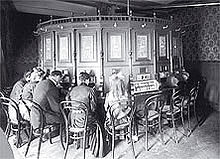Kaiserpanorama

The Kaiserpanorama (or Kaiser-Panorama) is a form of
stereoscopic glass slides. By 1910 he is said to have controlled exhibitions in over 250 branches across Europe
, and in the central archive have up to 100,000 slides stored.
Description

A kaiserpanorama would normally have around 25 wooden stations, each with a pair of viewing lenses. Inside the device there would be a rotating mechanism showing numerous
stereoscopic
images on rear-illuminated glass, giving a 3D effect.

Reconstructions
Various modern reconstructions, as well as a few authentic remaining kaiserpanoramas, exist in the
Deutsches Technikmuseum (Berlin), the Dusseldorf Film Museum, the Teylers Museum (Haarlem, Holland) and the Fotomuseum Antwerp. Another example is the Warsaw Fotoplastikon,[1][2] built in 1905, which, despite very similar design, is not under the name kaiserpanorama. During the German occupation, it was used by the Polish resistance
as a meeting point.
There was a dismantled kaiserpanorama in Snibston Discovery Museum in Coalville, Leicestershire, UK. However, since the museum is now closed, the item is now in storage and under the care of Leicester City Council
.

The museum of the occupation at the Oskar Schindler's Enamel Factory in Kraków, Poland, uses a fotoplastikon to show historical pictures.
References
- ^ (in Polish) Fotoplastikon Warszawski.
- ^ Fotoplastikon Warszawski Archived 2018-05-10 at the Wayback Machine.
External links
Wikimedia Commons has media related to Kaiserpanorama.
- http://www.aiq.talktalk.net/3D/kaiserpanorama.htm Archived 2014-02-22 at the Wayback Machine
- http://inthejungleofcities.wordpress.com/2011/02/06/the-kaiser-panorama/
- http://ignomini.com/photographica/stereophotovintage/kaiserpanorama/kaiserpanorama.html
- http://dmim-blog.com/2012/12/28/the-kaiser-panorama/
